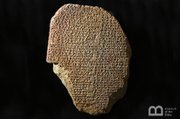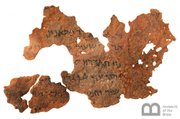In Washington, D.C., separation of church and state isn't just a principle of governance. It's an architectural and geographic rule as well.
Pierre L'Enfant envisioned a national church on Eighth Street. A patent office was built on the site instead. More than 100 years later, the city finally got its National Cathedral--far from Capitol Hill in the northwest corner of town. The downtown skyline is dominated by monuments to men; the Holocaust Museum and altarpieces in the National Gallery of Art are the closest things to religion you'll find on the Mall. Washington has its believers, but they practice too many faiths to fit under one roof.
Now, though, the Good Book is coming to town in a big way. The Museum of the Bible--backed by the evangelical owners of craft store Hobby Lobby, who famously took their objections to contraception and Obamacare to the Supreme Court--is set to open in 2017 just off the Mall. The proximity of the museum to the Smithsonian and the Capitol has raised eyebrows. How will it fit in? How will it function in a multicultural city? And what version of the Bible will we get?
To many in the scholarly community, the museum seems like an oversize piece of evangelical claptrap. Some academics and curators also worry about the origins of its collection; the more than 40,000 biblical artifacts were amassed in a remarkably short time by Hobby Lobby president Steve Green.
But the museum is trying to pitch itself as deserving of its spot. In August it inked a deal to display a selection of objects from the Israeli government's eminent Antiquities Authority. And it has hired David Trobisch, a prominent liberal academic, to head its collection. It will be up to Trobisch to transform this intriguing assembly of artifacts into an institution that brings a bit of church to a secular state.
At the heart of the Museum of the Bible is the Green Collection, a huge, disjointed assemblage that includes pieces of the Dead Sea Scrolls, a Gilgamesh tablet, Elvis Presley's Bible and about 850 manuscripts, 12 of which are in Hebrew and come from China's Jewish population. A third of the material is related to Judaism and the Old Testament, including torahs that survived the Spanish inquisition and the Nazis.
Why did Green want to turn his private collection into a museum? A number of academics have questioned his
family's motives. "I don't expect the Bible Museum to be anything other than a tax-deductible kitsch attempt at spreading Christian fundamentalist propaganda," archaeologist Dorothy King said. In an interview with NPR, Jacques Berlinerblau, a professor of Jewish civilization at Georgetown University, questioned the location of the museum, two blocks south of the Mall, where it might overlook periodic rallies opposing abortion or same-sex marriage, offering brick-and-mortar moral support to conservative causes. Sarah Posner concurred, writing in Talking Points Memo: "The museum will be a living, breathing testament to how American evangelicalism can at once claim it is under siege from secularists, the LGBT rights movement, or feminism--yet also boast of acquiring a prime private perch, strategically located at the nation's epicenter of law and politics."
There also have been questions about what approach to the Bible the museum will take. Green has promoted a public school curriculum based on the Bible as a factual historical text. Museum president Cary Summers consulted for the Creation Museum in Kentucky, which teaches creationism as fact, with didactic material showing dinosaurs and humans living side by side on a 6,000-year-old planet Earth. The Summers link has prompted unflattering comparisons of the two museums.
The Green family's initial public line on the Museum of the Bible seemed to confirm some of the concerns. The museum's 501(c)(3) filing in 2011 declared that its mission would be "to bring to life the living Word of God, to tell its compelling story of preservation, and to inspire confidence in the absolute authority and reliability of the Bible."
But the museum's mission statement has shifted. In 2012, references to the Bible's authority and reliability disappeared from the 501(c)(3) filing, and by 2013 it had transformed to the benign: "We exist to invite all people to engage with the Bible[.] We invite Biblical exploration through museum exhibits and scholarly pursuits."
The latest artist renderings of the museum, designed by architectural firm SmithGroup JJR--the same firm designing a proposed LGBT museum in the city--show a trapezoid of red brick and glass, topped with an observatory floor that resembles a glass pillow. The design is a huge departure from initial concepts, which imagined the museum shaped like an ark or a crown, or even modeled on Versailles.
Beyond the possible motives for the Museum of the Bible, some scholars question the collection itself. Green began spending heavily on it in 2009. He had amassed more than 30,000 items by June 2010 and has added 10,000 more since. "They purchased what I know were A-plus collections," said Sharon Liberman Mintz, a senior consultant for Judaica at Sotheby's who has met with the Green Collection team.
That 40,000 number, however, is suspicious to Roberta Mazza, a leading scholar and professor at University of Manchester in Britain. The UNESCO convention controls the export of antiquities and makes it difficult to legally sell abroad objects that were excavated after 1970. Mazza wonders how Green managed to collect so much "in such a brief period of time and in the context, in theory, of a strictly regulated antiquities market."
And then there was the handling of objects by the collection's original director, Scott Carroll. In one online video, Carroll dissolves an ancient Egyptian mummy mask with Palmolive soap in search of textual fragments that may have been recycled into the wrapping--actions that are not illegal but are understandably distressing to the museum community. In the video, Carroll says: "You might say, 'What a destructive process.' But I would remind you that all archaeology is a destructive process."
The Greens and Carroll parted ways in 2012, and last year the museum hired Trobisch, a non-evangelical liberal European intellectual whose background makes him a surprising match for the family. Trobisch once shared the cover of Free Inquiry, a secular humanist magazine, with atheist Christopher Hitchens and wrote about his scholarly and unorthodox theory that Bishop Polycarp of Smyrna, not Saint Luke, was responsible for the biblical Book of Acts and that this second-century bishop "edited" the New Testament, deciding which books should be included.
The new director describes his contact with the Greens as only occasional and says the family has no hands-on influence on how the museum will be curated. Money for the museum is placed into a charitable 501(c)(3) organization, which Trobisch and his team manage. He admits he had been concerned that there might be interference, but so far so good. "Steve Green does not take any active role in the day-to-day business," he says. "The decisions about the collection are made by me and my team."
Trobisch's first task when he arrived was to examine the objects--their history, their authenticity and how they were acquired--a process that's ongoing and includes a team of a dozen researchers. He says he has yet to find a questionable piece. He adds that he is regularly offered items as donations, and that if they are undocumented or of suspicious provenance they are not accepted. "Under my directorship, we will also not display any items found in the collection where we have no provenance records," he says.
The museum's recent deal with the Israel Antiquities Authority, that country's pre-eminent archaeological organization, is a major coup. Per the agreement, the Museum of the Bible will include permanent and rotating exhibits of objects from the agency's collection of two million artifacts. Jacob Fisch, executive director of the Friends of the Israel Antiquities Authority, explained the partnership to the New York Times, saying: "We share one mission, and that's telling the story that is based on the archaeological material. We're very scientifically based, research based."
But while Green may have built his collection and conceived of displaying it to encourage personal devotion, the museum's mission seems to be expanding. "When you walk into the museum," Trobisch says, "the first thing you'll see is a big collection of Bibles that you can buy in bookstores today. They all have different numbers of books [in them], and there are myriad differences. The idea that there's one Bible and a canon that everyone agreed on is just wrong." Visitors also will be able to choose from audio guides loaded with five religious belief systems.
When the doors open in 2017, the Museum of the Bible may surprise the Greens as much as the general public--freeing visitors to choose their own interpretation of the Word.
Editorial on 10/04/2015


